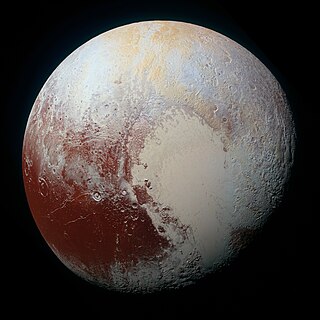
Planetary nomenclature, like terrestrial nomenclature, is a system of uniquely identifying features on the surface of a planet or natural satellite so that the features can be easily located, described, and discussed. Since the invention of the telescope, astronomers have given names to the surface features they have discerned, especially on the Moon and Mars. To found an authority on planetary nomenclature, the International Astronomical Union (IAU) was organized in 1919 to designate and standardize names for features on Solar System bodies.

Bohnenberger is a lunar impact crater that lies near the east edge of the Mare Nectaris, in the foothills of the Montes Pyrenaeus mountain range that forms the perimeter of the mare. To the east beyond the mountains is the larger crater Colombo. The crater has a low rim along the north wall, and the floor is somewhat irregular with a ridge crossing the floor. There is a small crater along the western inner wall.
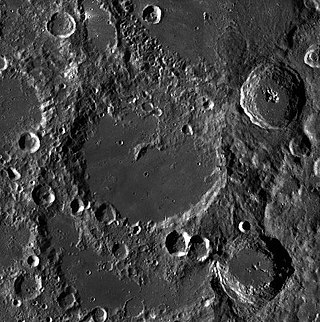
Von Kármán is a large lunar impact crater that is located in the southern hemisphere on the far side of the Moon. The crater is about 180 km (110 mi) in diameter and lies within an immense impact crater known as the South Pole–Aitken basin of roughly 2,500 km (1,600 mi) in diameter and 13 km (8.1 mi) deep. Von Kármán is the site of the first soft-landing on the lunar far side by the Chinese Chang'e 4 spacecraft on 3 January 2019.

Mons Hadley is a massif in the northern portion of the Montes Apenninus, a range in the northern hemisphere of the Moon. It has a height of 4.5 km (2.8 mi) 14,764 ft (4,500 m) above the adjacent plain and a maximum diameter of 25 km at the base.
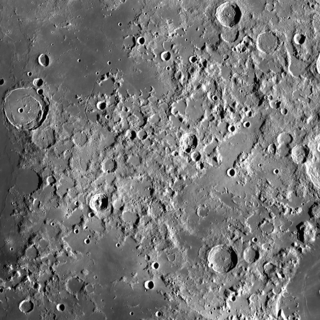
Montes Taurus is a rugged, jumbled mountainous region on the Moon. It is located to the east of the Mare Serenitatis, in the northeastern quadrant of the Moon's near side. Coordinates of their center are 27.32°N 40.34°E, and their extent is about 170 km.
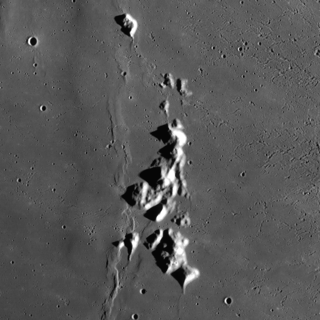
The Montes Spitzbergen is a solitary mountain chain in the eastern Mare Imbrium of the Moon. It is located about 80 km to the north of the flooded crater Archimedes. The range trends from south to north, consisting of a number of peaks separated by lava-flooded valleys, and has a maximum width of about 25 km. It is thought to be the surviving rim or inner ring of an impact crater that has been buried under magma flows.
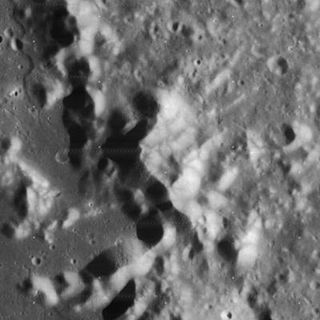
Mont Blanc is a mountain in the Montes Alpes range on the Moon. It is located on the western edge of the range, near the shore of Mare Imbrium, at 45.48°N 0.42°E. Its width is about 25 kilometers; the height is 3.7–3.8 km above adjacent plains of Mare Imbrium and 1.12 km above lunar level of zero elevation.
Odin Planitia is a large basin on Mercury located at 23.3° N, 171.6° W. It was named after the Norse god Odin in 1976 by the IAU. A large volcanic dome 7 km in diameter and 1.4 km high is situated near the center of Odin.

The Misty Montes are a range of mountains on Titan, the largest moon of the planet Saturn. The range is located in the northern hemisphere of Titan, between 56-7° north and 61-3° west.
The Irensaga Montes is a range of mountains on Titan, the largest moon of the planet Saturn. The range is located near Titan's equator, between 5-6° south and 210-214° east. It is located within the Adiri region, just west of the landing site of the Huygens probe.
The Mindolluin Montes are a range of mountains on Titan, the largest moon of the planet Saturn. The range is located near Titan's equator, between 1-4° south and 205-213° east. It is located within the Adiri region, just west of the landing site of the Huygens probe.

The Mithrim Montes are a range of mountains on Titan, the largest moon of the planet Saturn. The range is located near Titan's equator, between 1-3° south and 126-8° west and consists of three parallel ridges that are oriented east-west, spaced about 25 km apart. They are located within the region Xanadu. The highest peak is about 3,337 m (10,948 ft) high and is located on the southernmost of the ridges; it is the highest known peak on Titan.
The Taniquetil Montes are a range of mountains on Titan, the largest moon of the planet Saturn. The range is located near Titan's equator, between 2-4° south and 211-214° west. It is located within the Adiri region, just west of the landing site of the Huygens probe.
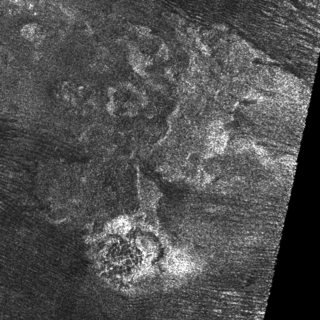
Doom Mons is the name of a mountain range and its eponymous peak on Titan, the largest moon of Saturn. A putative cryovolcano, it is the largest mountain range on Titan by volume, and at 4,757 ft (1,450 m) one of the highest in the Solar System. It was discovered by the Cassini–Huygens probe in 2005 and officially named in 2012.

Mons is a mountain on a celestial body. The term is used in planetary nomenclature: it is a part of the international names of such features. It is capitalized and usually stands after the proper given name, but stands before it in the case of lunar mountains.

Mount Marilyn is a lunar mountain within the Montes Secchi, which separate Mare Fecunditatis to the east from Mare Tranquillitatis to the west. It was named at about the time of the Apollo 8 mission to the Moon in 1968 by astronaut Jim Lovell for his wife, Marilyn. The name was informal until July 26, 2017, when it was officially recognized by the IAU. Its approximate position is 40 degrees E, 1.1 degrees N.













